
Volume XIV, Issue VIII
Josiah
By Bob Kirchman
Copyright © 2018, The Kirchman Studio, all rights reserved
Chapter 8: Déjà Vu All Over Again
That ship never came. For decades the little band struggled on. Josiah struggled to lead them. A small core of APOLLONIUS devotees were always perturbed that the collective mindset originally prescribed was not adhered to. They were led by Mark and Sergey, who had barely made it through Elizabeth Zimmerman’s vetting process. Though the group as a whole dispensed rapidly with addressing each other by number, Mark and Sergey resisted that change to the bitter end. Finally it was only them referring to each other by number anyway. Then they gave it up.
The problem was that the two of them brooded together privately and stirred up some dissention publicly. Sergey would often interrupt Josiah with the statement, “that’s not by the book.” He was committed to restoring the purity of the original colony mission as he saw it. Josiah’s leadership was necessary now but in the long run it would have to go.
The two doctors gravitated to this mindset. They arrived at the colony both expecting and when their babies came they attached themselves to some men of the APOLLONIUS faction. APOLLONIUS was not the only person on Earth pushing for colonization, they reasoned. Others would follow and they would be the charter village of the new order when the latecomers arrived. Josiah had inventoried the remaining stores and they were actually not in any immediate danger of depleting resources. The doctors, for their part, did not strongly resist the change to home education. They considered their children the rightful heirs of APOLLONIUS and intended to raise them as such. Combined education might indeed get in the way of that.
Then there was the Allison/Josiah faction. They held rule of the colony by necessity and because of Josiah’s giftedness in that area. Even their enemies acknowledged this. The loss of APOLLONIUS had left most of the colonists quite rudderless if the truth be known. Steeped in the Progressive thought that had been overshadowed by a rebirth of Faith in the North Country, they were quite capable of creating institutions but clueless as to the deeper stirring of human nature that seemed to make them run so wretchedly.
The new colony was to have no prisons, but it became clear over the years that the folly that necessitated them was still present in humankind. Though they had cast off all of the antiquated beliefs and institutions, they were surprised at the dark shadows that had followed them across the solar system. Josiah dealt with the raft of petty crimes within the community with an application of something very much resembling the old ‘Golden Rule.’ When thievery was discovered, restitution was expected. Abusive and violent situations were not so easy. Initially mandatory separation of the aggressive parties seemed to work, but then there was the murder.
(to be continued)
Billy Graham Dies at 99
America's Pastor Now in Glory
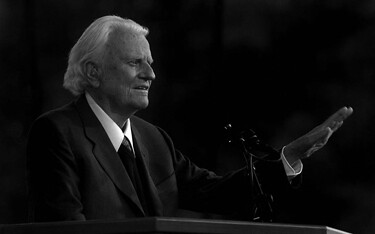
Many of us thank Billy Graham for introducing us to the Kingdom of Heaven. At 99 years of age, he has now tasted it in its fullness.
Winter at Wrightsville Beach
Nineteenth Century North Carolina Ocean Playground

In 1853 the Carolina Yacht Club, currently the second oldest east coast yacht club (NY Yacht Club established in 1844), was founded on The Banks, which later became Wrightsville Beach. Here an azalea blooms in February on the leeward side of the Yacht Club building.

A Winter morning dawns over the dunes of Wrightsville Beach, North Carolina.
Nineteenth Century beachgoers flocked to the shore on a streetcar line that ran from Wilmington, North Carolina to the beach. In 1889 A trestle across Banks Channel was constructed and by 1906 there was direct Pullman service from Atlanta, Georgia to Wrightsville Beach. In 1901 Consolidated Railways, Light and Power Company was formed. Not only did they power the trolleys, they provided free electricity to the residents of the beach. It remained free until 1917!
In 1905, Lumina, the “Beautiful Place of Lights” was built by the power company as an entertainment destination. The three story pavilion featured a magnificent ballroom with the first scientifically designed band shell on the East coast. It became known as the “Showplace of the Atlantic.” It was damaged substantially in 1954 by Hurricane Hazel and was demolished in 1973.
Wrightsville today is a community of beautiful beach cottages and some nice hotels, but the name of Lumina Avenue recalls a day when Wrightsville was an ‘Electrical Prototype Community of Tomorrow!’ [1.]
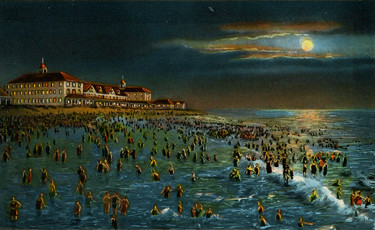
Guests Enjoying Moonlight Bathing, from a turn of the century tinted postcard, at Wrightsville Beach’s Seashore Hotel. The Seashore Hotel, considered an early showplace on the island, opened with 180 rooms (150 with fireplaces) on the current site of the Blockade Runner Hotel. The Seashore Hotel was destroyed by fire in 1919, but rebuilt in 1922…

…the Contemporary Blockade Runner Hotel replaced it in 1964, becoming the largest hotel on Wrightsville Beach.

The Gardens of the Blockade Runner Hotel in Wrightsville Beach, North Carolina.
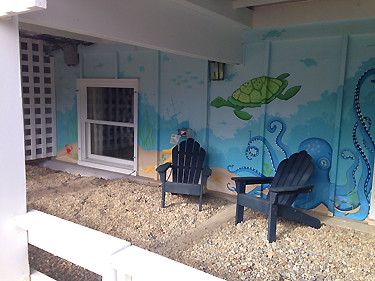
The space under a porch on Wrightsville Beach's Lumina Avenue becomes a special place for children, touched by the hand of an unnamed muralist.

The Lumina Pavilion, from an old post card.
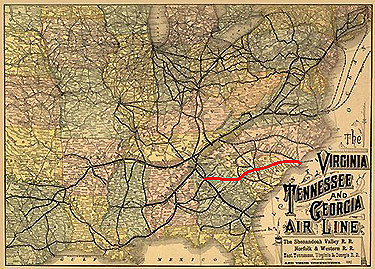
Direct Pullman Service from Atlanta.
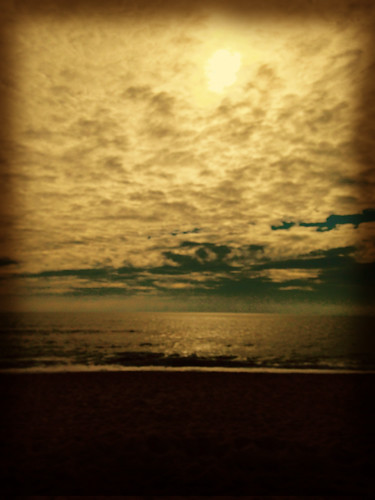
The Atlantic Ocean on a Winter Morning. Photo by Bob Kirchman.
The ‘Tomorrowland Problem’
by Bob Kirchman
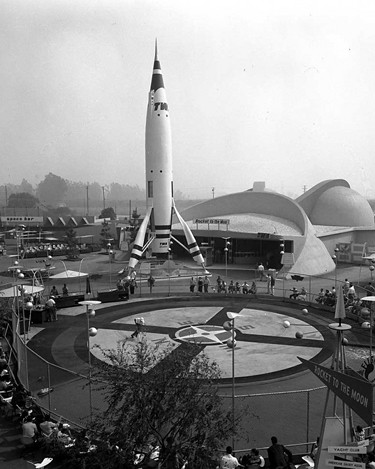
Disney's Tomorrowland in 1955.
Basically, when you create a detailed vision of the future—it’s the PRESENT! That, in a nutshell, is the ‘Tomorrowland Problem.’ In 1955 Walt Disney opened the ‘Tomorrowland’ portion of Disneyland, complete with a ‘TWA’ passenger rocket that resembled a German V2. It was exciting in its day but a mere 15 years later man had walked on the moon. The exhibit was dated. Epcot’s futuristic ‘permanent world’s fair’ created a similar problem. Tomorrowlands all too quickly became deco visions of the past attempts to visualize the future.
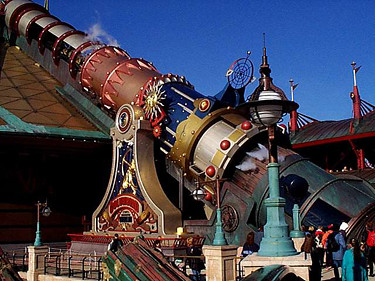
Disney Paris's Jules Verne Imagery.
For Disney Paris, a wonderful solution presented itself. Harper Goff had created a Jules Verne submarine for 20,000 Leagues Under the Sea which was a wonderful study in what Victorian and Edwardian engineers might have come up with (Verne’s own illustrations of the Nautilus were of a sleek and simple boat). In Disney Paris, the huge canon from From the Earth to the Moon launches riders on a variation of Disney’s popular Space Mountain. The whole Jules Verne concept was intriguing and quite successful.
Now Disney Imagineers looked to Tomorrowland in Disney World, Florida. They saw the glow coming off of that park’s iconic Space Mountain and so they painted over the white sculptural mountain in greens and browns. It was an awkward modification—eventually reversed, but it taught us something about the soul of the architecture.
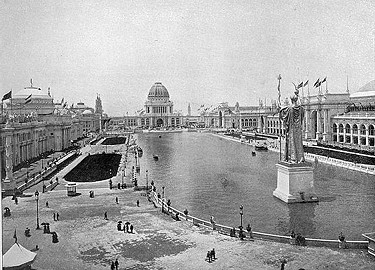
Chicago's 1893 World's Fair.
In 1893, Chicago hosted its world’s fair and presented an America bouncing back from a devastating Civil War a pristine ‘White City’ based on classical forms. Here the past was invoked to influence the future. Chicago kept some of the classical buildings as public structures and inspired a great building of classical architecture across the nation. This continued well into the early decades of the Twentieth Century and enriched many an American small town and city!
But in those same decades, a modern architecture developed. Some of it, unfortunately was sparse at best and at times brutally ugly. Even Albert Speers’s ‘Germania,’ though classical, was brutally scaled and diminished the human inhabitant. A dark, monolithic vision for the future emerged. With the defeat of the National Socialists, Europe rebuilt herself with the help of the Marshall Plan. A lot of Europe’s beautiful architecture was rebuilt, but a lot of charming neighborhoods, destroyed by war, were rebuilt in Le Corbusier style apartment blocks. (Thank HEAVEN the Nazis did not burn Paris)! In the United States, the same design was applied to public housing.
In 1964, the New York World’s Fair became a vision for the future as well. The buildings were bold and some of them seem quite outlandish today. Those who remembered the 1939 New York fair might find it quite similar to the 1955 Tomorrowland in the way its imagery has aged.
When I started creating the future world of Big Diomede for the PONTIFUS series, I purposely looked to the past—a lot like the architects who built the ‘White City.’ The Disney Corporation never built EPCOT as an inhabitable city like Disney originally envisioned it. They later created ‘Celebration,’ a decidedly more traditional community. Even in Brazil’s futuristic capital, traditional style homes have popped up in its outlying neighborhoods while in the center workers struggle to maintain the ultramodern government buildings.
The lessons to be learned are probably that the future arrives all to quickly and overshadows our attempts to render it and that the past is always a good resource as we seek to go forward.
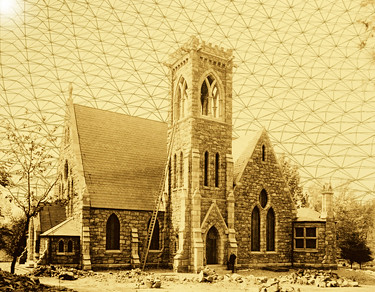
The Chapel in the Big Diomede Biosphere under construction.
